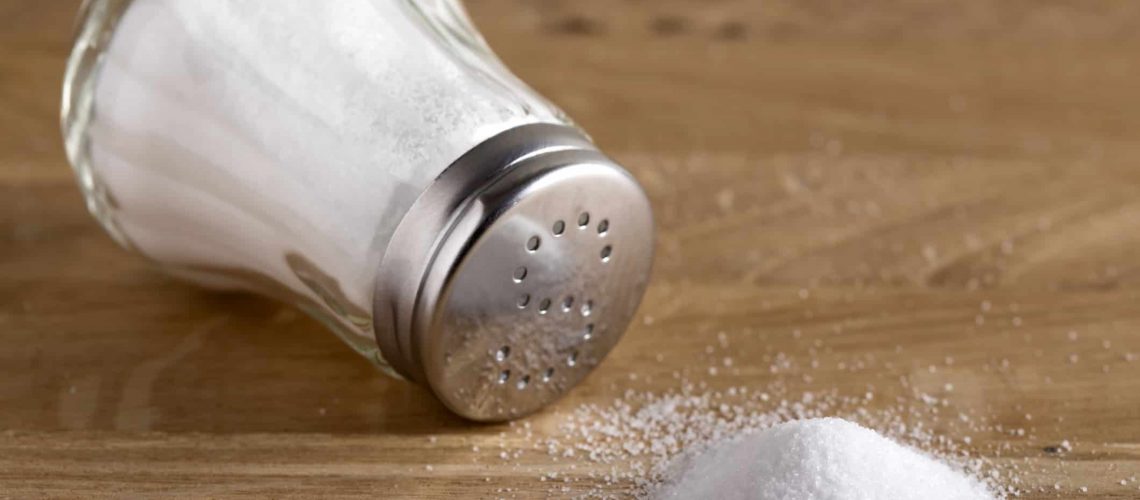When most people think about salt, the first image that comes to mind is of the tiny white grains that we might sprinkle on our food to liven up an otherwise bland dish. Many people forget that salt is also an essential mineral for most living things, responsible for regulating the levels of fluid in the body and aiding electrical signalling in the nervous system. Without salt we could not survive, but a consistently high intake can take a devastating toll on our health, and for that reason over recent years the UK Department of Health and World Health Organisation have continued to lower their recommendations on the amount we should limit ourselves to every day.
The main reason salt is vilified so much is its effect on blood pressure and the consequences that this can have on the cardiovascular system. A fine balance of the minerals sodium and potassium is needed to pull fluid through the walls of blood vessels from the blood stream and into the kidneys, where it is then filtered and excreted as urine. A diet high in salt (essentially comprised of sodium and chloride) alters this balance so that there is an increased volume of fluid in the blood, which increases the pressure exerted against the walls of the blood vessels. Raised blood pressure is estimated to be responsible for 62% of stroke and 49% of coronary heart disease cases in the UK, and is also a significant risk factor for vascular dementia, diabetes and kidney disease. It has been estimated that a reduction per day from 10g to 6g of salt would result in 19,000 fewer deaths from stroke and coronary heart disease per year in the UK, and 2.6 million per year worldwide.
Independently of this salt is strongly associated with an increased risk of gastric cancer, with one study demonstrating a 68% higher risk of stomach cancer in those with a high salt diet versus a low salt diet and another concluding that the risk of developing stomach cancer increased by 8% for every gram of salt consumed per day.
It is currently recommended that adults do not consume more than 6g of salt a day, which to look at is about one teaspoon. On nutritional labelling there is often only a figure for sodium rather than salt per se, but be aware – the true salt content of a dish is 2.5 times its sodium content, and so if you are working from nutritional labels alone, you need to be aiming for a sodium intake of 2.4g per day or less. Thankfully these days many foods have a “traffic light” coding system on the front of the packaging to help us determine more easily which foods are the healthier choice, defined for salt/sodium as follows:
High = 1.5g salt or 0.6g sodium per 100g
Medium = 0.3-1.5g salt or 0.1-0.6g sodium per 100g
Low = 0.3g salt or 0.1g sodium per 100g
One simple way to reduce the amount of salt we eat is of course not to add it at the table and to watch how much we use when cooking. Foods with an inherently salty taste like anchovies, olives and smoked fish will naturally have a high salt content, but salt is also hidden away in some surprising places, as you will see from the table below. A particularly surprising source is the effervescent preparations of some vitamin and painkilling tablets, which can contain up to 1g of salt each.
6g of salt per day might sound like an easy target to achieve, but based on the estimations below, one bacon sandwich with ketchup would mean that you are two-thirds of the way through the recommended daily intake before even leaving the breakfast table in the morning! Although it might seem like a bore, becoming a bit more salt aware is no bad thing, particularly if your blood pressure is elevated. The British Heart Foundation has a useful booklet, Cut Down on Salt, with ideas about swaps you can make to reduce your salt intake. Download a copy here. Public Health England also has an app called Change4Life, which allows you to scan barcodes in the supermarket to get salt, sugar, fat and calorie information about the foods you are buying, and suggestions for healthier alternatives. Find out more information about the app here.
A trial presented in August 2021 at the European Society of Cardiology Congress showed that using a lower sodium salt substitute instead of regular salt was associated with a 14% reduction in stroke, a 13% reduction in major cardiovascular events and a 12% reduction in death over a five year period.
Salt substitutes, which replace part of the sodium chloride in regular salt with potassium chloride, are available in many countries worldwide and represent a very simple and inexpensive way to improve cardiovascular health.
Read the full article from the New England Journal of Medicine here.
